“And suddenly there is Cagliari,“ wrote DH Lawrence. “A naked town rising steep, steep, golden-looking, piled naked to the sky.” Adrian Mourby explores this ancient Sardinian city…
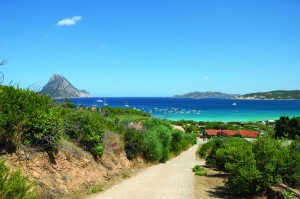
You have to choose your angle these days to see the Sardinian capital as Lawrence did in 1921, but the Aragonese fortress (known as Castello) still towers over the city. And it’s still a steep slog up the three flights of steps that link Marina down below to the castle quarter and Piazzetta David Herbert Lawrence. The plateau was created by the Savoyard kings at the end of the 19th century and renamed in Lawrence’s honour. It has fantastic views out to sea – and rather a lot of graffiti these days.
“It is strange and rather wonderful,” Lawrence noted. “The city piles up lofty and almost miniature, and makes me think of Jerusalem: without trees, without cover, rising rather bare and proud… One wonders how it ever got there. And it seems like Spain or Malta: not Italy. It is a steep and lonely city, as in some old illumination.”
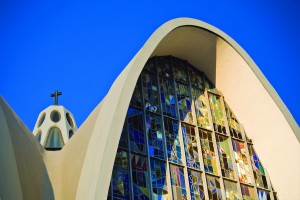
The capital of Sardinia – currently vying to be European Capital of Culture in 2019 – is a curious place, the result of its equally curious history. A rock above what was once little more than a navigable swamp, it was hugely fortified by its various owners – the Pisans, Genoese, Aragonese, and Savoyards – while the native Sardinians huddled down below in the port (now called Marina) and outside the walls (the districts of Stampace and Villanova). Mediaeval Cagliari was defended by massive open-backed towers like you see in Valencia and Genoa, and crowned by a cathedral that’s Pisan-Romanesque outside and Baroque within. Inside, it displays the old font from Pisa Cathedral cut in two and placed either side of the main door like a pair of matching balconies. As Lawrence said, strange and wonderful.
I arrived here by car at the end of a north-south drive through Sardinia. Ahead of me Cagliari rose on the horizon like two fortified medieval peaks. One was Castello and the other the hilltop Sanctuary of San Bonaria. A few ill-advised blocks of 20th-century flats marred the city’s profile, but mostly it looked just as Lawrence described, a “steep and lonely city” tucked into a bay that faces across the sea to Tunis.
Closer to the city centre I found that the old fortified city was surrounded by Liberty-style apartments from the first years of a united Italy. It’s ironic to think that the House of Savoy, under whose rule Italy was united in 1870 actually hid out in Cagliari during the Napoleonic Wars. For 16 years the Vice Regal Palace up in Castello was the only place they felt safe.
Following the road ever downwards I managed to locate Via Roma, which follows the line of Cagliari’s 19th-century quayside. I drove in past Palazzo Civico, a Liberty-style turreted fortress in white limestone that has to be the most idiosyncratic building in Cagliari, and found somewhere to park (not a cheap option in Cagliari). My hotel had been recommended by a friend for its position overlooking the harbour.
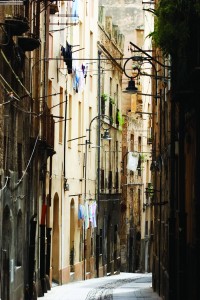
I was welcomed by Luigi, the patron, who told me how this gargantuan seafront apartment block had once received the greatest singers of Italian opera. He showed me photos of his grandchildren and poured us both a glass of his family’s 15-year-old Vernaccia Reserve. Then I was shown to my room, one of those tall, narrow Italian chambers whose curtains and shutters squeeze shut out all light. Yet once I’d dropped my bags on the bed, and nearly broken the shutters to get them open, the view was superb: the sea and, across the harbour, the setting sun. This was going to be an interesting city to explore.
The next morning I got lost in the back streets behind my hotel, but did so deliberately. Just wandering the Marina district was fun. At Trattoria Lillicu in narrow Via Sardegna, I met T-shirted waiters setting out tables for lunch. I was offered a glass of water – it was already very hot – but our conversation was stilted. Very little English is heard in Cagliari and the Italian that is spoken is not easy on the ears.
Next door to Lillicu was Enoteca, a great shop for good-value Sardinian wines with shelf-loads of rums and whiskies. I bought two bottles of Malvasia, produced just outside Cagliari, and lugged them around with me for the rest of the morning. It was a terrible mistake, I realised, as soon as I started the climb to Castello.
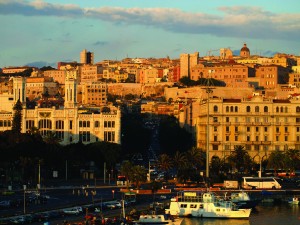
Heading up flight after flight of steps, I stopped off for an ice cream at Caffè Antico, which opened its doors in 1855 as Caffè Genovese on Piazza Costituzione. Antico Caffè sits just below the St Remy Bastione, an impressive double staircase under a massive arch that leads between the upper and lower parts of the city. The House of Savoy constructed this monument after the Unification of Italy when it was thought the fortifications around Castello could afford to be less fearsome. After admiring the view and all the wares that North African salesmen had spread out across Piazetta David Herbert Lawrence, I walked up to the Cathedral.
The mosaics on the white limestone exterior and the vivid contrasting marble within create a powerful impression. A side chapel to the right of the altar contains a photograph of Maria Cristina, youngest daughter of King Victor Emmanuel I of Sardinia. Maria Cristina (1812-1836) was the shy Princess Diana of her day. Her unhappy marriage to the King of Naples ended abruptly when she died in childbirth, and in 2014 she was beatified by the Pope.
Wandering further up the narrow streets of Castello, I passed lots of quiet little shops and eating places: The Cravates Man sells ties outside his house at 27 Via Nicolo Canelles for €5 each. “The Old Coffee” is a snack bar whose shelves are lined with old musical instruments, cameras and tape recorders, and there’s a wonderful antique shop on Via Alberto Lamarmora full of dusty old dolls and antique prints.
The highest point on Castello is the royal arsenal, built in the 1820s by King Carlo Felice of Savoy, uncle of Maria Cristina. Today it’s known as the Citadel of Museums for its five exhibitions, which include the extraordinary Museo delle Cere Anatomiche Clemente Susini.
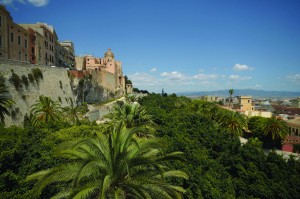
From the Citadel I began my descent past the Torre Dell’Elefante, which is one of three massive towers remaining from the 14th-century fortifications built when Pisa controlled Cagliari. It’s 31 metres high and built on three sides in white local limestone. The inner fourth side is open, as was the practice with all of Cagliari’s medieval defensive towers. For €3 you can climb five flights of steps to get another great view across the harbour and out to sea.
Passing through the gate – warily because of its very fierce-looking portcullis – I headed back down the steep streets to the marina and the cool calm of my small, dark room above the arcades on Via Roma. It was time for a siesta, as is common practice in sun-baked Cagliari. And after all that walking, I too needed the rest – if only to prepare myself for the evening. I had promised myself dinner at Dal Corsaro, possibly the best restaurant in the city, whose chef, Stefano Deidda, is also something of a poet. Of Cagliari he wrote on the menu “Here the wind shapes the faces – and the sun warms the hearts – of those who live in a seaside town at a crossroads of trade”.
Cagliari does seem to bring out the poet in people.
Feeling inspired to book a trip to Cagliari this summer? Click here for top tips on where to stay, where to eat and what to see and do.
All images © iStock
